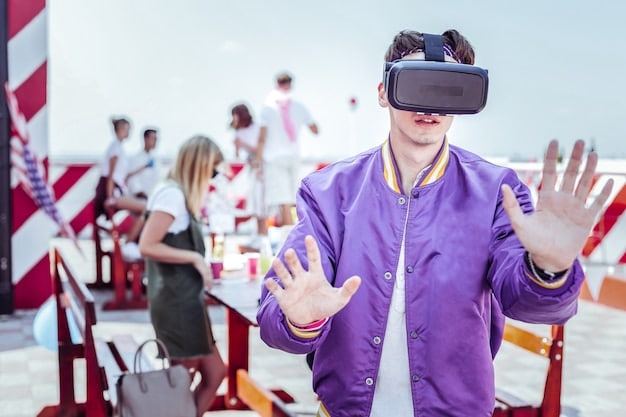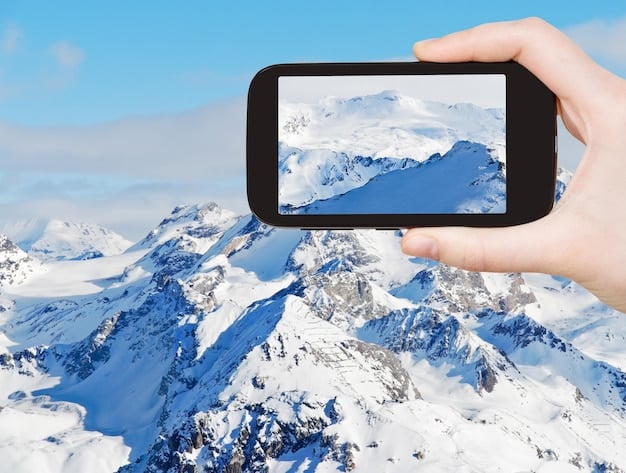Virtual Reality in Travel Journalism: Immersive Storytelling’s Impact

The impact of virtual reality on travel journalism is revolutionizing how stories are told, offering immersive experiences that transport audiences to destinations through digital innovation and enhanced storytelling techniques.
The world of travel journalism is undergoing a significant transformation, and at the forefront of this evolution is the immersive power of virtual reality. Through advanced technology and innovative storytelling, virtual reality is offering audiences unparalleled experiences that go beyond traditional articles and photographs. This article explores how VR is reshaping travel journalism, providing deeper insights into its potential and impact.
The Rise of Virtual Reality in Journalism
Virtual reality (VR) has rapidly evolved from a niche technology to a mainstream tool, impacting various industries, including journalism. Its ability to create immersive, interactive experiences is particularly beneficial for storytelling, offering new ways for journalists to engage audiences.
The adoption of VR in journalism is driven by its capacity to deliver richer, more engaging narratives compared to traditional mediums.
Immersive Storytelling
VR enables journalists to create stories that place the audience directly in the middle of the action, enhancing their sense of presence and empathy.
Enhanced Engagement
By providing interactive experiences, VR captures and maintains audience attention more effectively than conventional methods.
- Experiential Learning: VR allows users to explore environments and cultures firsthand, fostering a deeper understanding.
- Emotional Connection: Immersive experiences can evoke stronger emotional responses, making stories more memorable.
- Accessibility: VR can bring remote or inaccessible locations to a global audience, broadening the reach of travel journalism.

In summary, virtual reality is becoming an integral part of journalism, offering immersive and engaging ways to tell stories, particularly in the realm of travel, fostering deeper connections and understanding.
Benefits of VR for Travel Journalism
The integration of VR into travel journalism brings numerous advantages, both for journalists and their audiences. These benefits range from enhanced storytelling capabilities to increased audience engagement.
VR enhances storytelling by allowing audiences to experience destinations in a deeply personal and immersive way.
Enhanced Storytelling
VR enables journalists to craft narratives that go beyond simple reporting, creating experiences that transport users to different locales.
Increased Audience Engagement
Interactive VR experiences capture audience attention and foster a greater sense of involvement.
- Deeper Immersion: VR provides a sense of presence that traditional media cannot replicate.
- Interactive Exploration: Users can explore destinations at their own pace, discovering hidden gems and unique perspectives.
- Emotional Resonance: VR experiences can evoke powerful emotions, making stories more impactful and memorable.
Ultimately, VR offers significant benefits for travel journalism, enhancing storytelling, boosting audience engagement, and providing unique experiential opportunities.
Challenges and Limitations of Using VR
While VR offers numerous advantages, it also presents several challenges and limitations that need to be addressed. These challenges range from technical issues to ethical considerations.
Despite its potential, VR faces obstacles that can hinder its widespread adoption in travel journalism.
Technical Barriers
The high cost of VR equipment and the technical expertise required to create VR content can be significant barriers.
Accessibility Issues
VR headsets are not universally accessible, limiting the potential audience for VR travel journalism.
- Cost Constraints: The expense of VR technology can be prohibitive for smaller news organizations and independent journalists.
- Technical Complexity: Creating high-quality VR content requires specialized skills in areas like 3D modeling and interactive design.
- Usability Issues: Some users may experience discomfort or motion sickness when using VR headsets.

In conclusion, while VR holds great promise, it is important to acknowledge and address the technical and accessibility challenges that can limit its use in travel journalism.
Ethical Considerations in VR Travel Journalism
The use of VR in travel journalism also raises several ethical considerations. These include issues related to authenticity, manipulation, and the potential for misrepresentation.
Ethical practices are crucial to ensure credibility and trust when using VR in travel journalism.
Authenticity and Accuracy
Maintaining the integrity of the travel experience and avoiding the creation of misleading or deceptive content is essential.
Privacy Concerns
Protecting the privacy of individuals captured in VR environments is a critical ethical consideration.
- Informed Consent: Ensuring that subjects are aware of and consent to being recorded in VR environments.
- Transparency: Clearly labeling VR experiences as such to avoid confusing audiences about the nature of the content.
- Avoiding Exploitation: Using VR to tell stories responsibly and ethically, without exploiting subjects or perpetuating stereotypes.
In short, ethical considerations are paramount in VR travel journalism to maintain trust and ensure responsible storytelling.
Examples of Successful VR Travel Journalism
Despite the challenges, there are numerous examples of successful VR travel journalism that demonstrate the potential of this technology. These examples showcase innovative storytelling and immersive experiences.
Several organizations have successfully leveraged VR to enhance travel journalism and engage audiences.
The New York Times VR
The New York Times has produced several VR travel experiences, including a virtual tour of Nepal following the 2015 earthquake.
National Geographic
National Geographic has created immersive VR experiences that allow users to explore remote locations and wildlife habitats.
- “Climbing Mount Everest”: This VR experience allows users to virtually climb Mount Everest, providing a breathtaking and immersive view of the world’s highest peak.
- “Meet the Chimps”: National Geographic has created immersive VR experiences that allow users to explore remote locations and wildlife habitats.
These examples demonstrate that VR, when used effectively, can enhance travel journalism by providing engaging and immersive experiences that resonate with audiences.
The Future of VR in Travel Journalism
The future of VR in travel journalism is promising, with continued advancements in technology and increasing adoption by news organizations and independent journalists. As VR technology becomes more accessible and affordable, its use in travel journalism will likely expand.
VR’s potential to transform travel journalism is significant, with ongoing advancements and increasing adoption.
Technological Advancements
Improvements in VR hardware and software will enhance the quality and accessibility of VR experiences.
Increased Adoption
More news organizations and independent journalists are expected to embrace VR as a storytelling tool.
- Enhanced Interactivity: Future VR experiences may incorporate more interactive elements, allowing users to engage with the environment and characters in new ways.
- AI Integration: Artificial intelligence could be used to create more personalized and adaptive VR experiences.
- Augmented Reality (AR) Integration: Combining VR with AR could create hybrid experiences that blend virtual and real-world environments.
| Key Point | Brief Description |
|---|---|
| 🌍 Immersive Experiences | VR provides a more profound connection to destinations. |
| 📸 Enhanced Storytelling | It allows richer and more emotional travel narratives. |
| 💰 Cost | High implementation costs can be a significant barrier. |
| 🧭 Authenticity | Maintaining real experiences is crucial for accuracy. |
FAQ
VR enhances travel journalism by offering readers immersive experiences that transport them to different destinations, creating a sense of presence and deeper emotional connection with the story.
The main challenges include high production costs, technical complexity, accessibility limitations due to the need for VR headsets, and ethical concerns regarding authenticity and potential manipulation of experiences.
The New York Times VR and National Geographic are great examples. They have created immersive experiences like virtual tours of Nepal and explorations of remote locations, greatly enhancing engagement.
Critical ethical considerations include ensuring authenticity and accuracy, respecting privacy by obtaining informed consent, maintaining transparency to avoid misleading audiences, and avoiding exploitation of subjects or perpetuation of stereotypes.
Future advancements may include more interactive elements and the integration of AI to personalize VR experiences. Improvements in VR hardware and software enhancing accessibility and quality coupled with augmented reality integration could create hybrid experiences, merging virtual/real worlds.
Conclusion
In conclusion, the impact of virtual reality on travel journalism is poised to revolutionize how stories are told, offering immersive experiences that connect audiences to destinations in unprecedented ways. While challenges remain, the benefits of VR for storytelling and engagement are undeniable, paving the way for a future where travel journalism is more immersive, interactive, and impactful than ever before.





